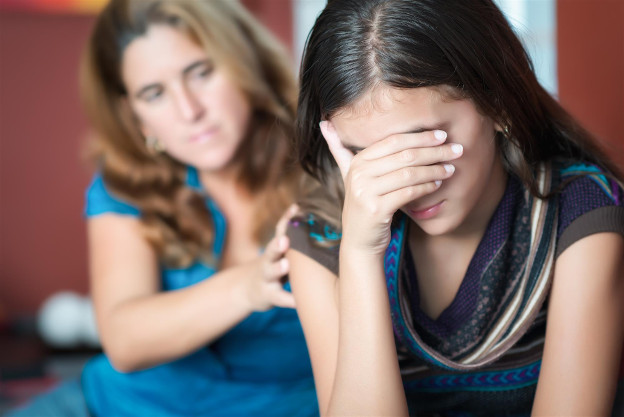UNDERSTANDING AND IDENTIFYING SOCIAL ANXIETY IN ADOLESCENTS
Social anxiety disorder is often confused with shyness by family members, friends, and teachers, but it’s much more than that.
For teens with social anxiety disorder, everyday social interactions can feel overwhelming. They may worry excessively about being embarrassed, humiliated, judged, or rejected, or of offending others in social situations.

These worries and fears can become crippling, causing young people to fall behind developmentally and academically. Children and teens with social anxiety disorder are also more likely than their peers (without the disorder) to develop depression and substance abuse.1
This is why it’s vital for healthcare professionals to understand and be able to identify the behavioral and physical symptoms of social anxiety disorder to advocate for patients with the condition.
Ahead, we’ll look at social anxiety disorder and its prevalence among adolescents in the U.S. in more detail, outline common symptoms of the disorder, and discuss the importance of identifying signs of social anxiety in adolescents. We’ll also talk about how teachers and healthcare facilities can take a proactive role in ensuring their staff is trained to recognize social anxiety disorder in children and adolescents.
WHAT IS SOCIAL ANXIETY DISORDER AND HOW COMMON IS IT AMONG ADOLESCENTS?
Social anxiety disorder is a persistent and irrational fear of social or performance situations. Exposure to unfamiliar people can be particularly anxiety-provoking; however, people with social anxiety disorder may also fear interacting with or performing in front of those familiar to them. People with social anxiety disorder fear they will be embarrassed, humiliated, judged, or rejected in social situations.
Social anxiety disorder can develop at any time, but it rarely occurs for the first time after age 25. The period of onset is usually in late childhood and adolescence.2
TYPES OF SOCIAL ANXIETY DISORDER
There are two subtypes of social anxiety disorder recognized by the 5 th Edition of the Diagnostic and Statistical Manual of Mental Disorders (DSM-V):3
- Generalized social anxiety disorder : Characterized by a persistent and debilitating fear of most social situations, activities, and interactions.
- Non-generalized social anxiety disorder : Characterized by a debilitating fear of certain types of social interaction or activity, especially public performance (e.g., giving a speech, speaking in front of a group, performing an act in public, etc.).
PREVALENCE AMONG ADOLESCENTS IN THE U.S.
According to diagnostic interview data collected by the National Comorbidity Survey Adolescent Supplement, an estimated 9.1% of adolescents aged 13-18 in the United States had social anxiety disorder at the time of the survey.4
The data also found that social anxiety disorder was more common in females (11.2%) than males (7.0%). An estimated 1.3% of adolescents had severe impairment.4
COMMON SYMPTOMS OF SOCIAL ANXIETY IN TEENS
It’s not uncommon for teens to get nervous in certain social situations. Asking someone out on a date, speaking in front of the class, or performing in front of others can understandably cause butterflies.
However, for teens with social anxiety disorder, these and other situations and activities can cause outright panic. Teens with social anxiety may:
- Exhibit extreme nervousness around classmates or teammates
- Avoid eye contact
- Avoid group situations
- Sit alone at lunch
- Be visibly shy and uncomfortable while being watched
- Feel very nervous meeting new people
- Make excuses to avoid certain social situations or events
Physical signs and symptoms of social anxiety can include:
- Fast heartbeat
- Blushing
- Sweating
- Trembling
- Upset stomach or nausea
- Mind-blanking
- Difficulty catching breath
- Dizziness or lightheadedness
- Muscle tension
Teens with social anxiety disorder often avoid social situations, such as attending parties, social gatherings, and school dances. They may have an excessive number of absences from school. Entering a classroom where students are already seated may cause extreme self-consciousness. They may avoid dating. Even using a public restroom may be very uncomfortable.

UNDIAGNOSED AND MISDIAGNOSED SOCIAL ANXIETY DISORDER
American culture tends to encourage and reward extraversion and gregariousness. Given this, parents of a child with social anxiety disorder might misunderstand or be insensitive to their child’s fears and anxieties around social situations. They might mistake their child’s hesitation in social situations as “shyness” or assume that because their child rarely acts out or gets into trouble that he or she is naturally self-disciplined.
It’s important to distinguish between shyness and social anxiety. While shy children may be more hesitant to approach others or speak in a group, they still engage with other kids and adults, albeit usually with less intensity than their peers. Shy kids do not typically become upset when they have to interact with others, while kids with social anxiety disorder are often upset and frightened by such encounters.
IDENTIFYING THE WARNING SIGNS OF SOCIAL ANXIETY DISORDER
In young children, social anxiety may present as selective mutism (fear of speaking to others or in front of others) outside the immediate family or close friends. In elementary school, children may stop participating in groups (such as Girl Scouts or Little League). In middle school, they may avoid social events and extracurricular activities, and, in high school, they may become withdrawn and depressed, which can lead to academic problems and drug use.
Parents can help prevent social anxiety from worsening by watching out for the following warning signs:
- Discomfort talking with peers, teachers, and others
- Blushing, trembling, or protective body language around other people
- Tantrums or crying when confronted with new people (especially young children)
- Avoidance of eye contact
- Speaking quietly or mumbling when addressed by others
- Complaints of stomach aches or headaches to stay home from school, field trips, or social events
- Withdrawal from activities
- Signs of depression or drug use (especially teens)
Parents who observe these signs should consult their family doctor as soon as possible to evaluate their child for social anxiety.
Since social anxiety disorder involves fear and anxiety that interferes with daily schedules, school, work and other activities, it is important for healthcare/mental health professionals, educators, and parents to be able to identify the symptoms of social anxiety disorder, so adolescents receive the help they need early on in life.

TREATING SOCIAL ANXIETY
Social anxiety disorder treatment usually involves a combination of therapy and medication.
- Exposure therapy is frequently used in the course of treatment. It involves gradual exposure to uncomfortable social situations until the person is eventually comfortable. Exposure therapy works by “rewiring” the brain’s fear response to social situations. Relaxation therapy, including deep breathing exercises and meditation, may also help.
- Certain medications for depression and anxiety have been approved by the FDA to treat social anxiety disorder. These include the selective serotonin reuptake inhibitors (SSRIs) Paxil and Zoloft, and the selective serotonin & norepinephrine inhibitors (SNRI) Effexor. These medications should be used with caution in teens, at the doctor’s discretion, since they can cause side effects, including headache, upset stomach, nausea, sleep trouble, and others.
- Beta-blockers (normally used to treat high blood pressure or heart problems) are effective for some people in treating performance social anxiety, specifically.
POSSIBLE LONG-TERM IMPACTS OF SOCIAL ANXIETY DISORDER
Social anxiety in children may be associated with long-term impairment, such as underemployment and risk for depression and substance abuse. It may also cause isolation, poor social skills, low self-esteem, and suicide or suicide attempts. Children who suffer from social anxiety may suffer from depression and vice versa. It’s vital for parents and teachers to be able to recognize the signs of social anxiety disorder.
HOW SCHOOLS/TEACHERS CAN HELP SOCIALLY ANXIOUS STUDENTS
Schools and individual teachers can help support students with social anxiety disorder by creating an environment in which students are comfortable expressing themselves.
Whenever possible, student support staff should work with socially anxious students on guided exposures at school, such as by accompanying the student to the cafeteria to initiate conversations, or to purchase foods, or to ask questions of the librarian. Connecting the student with an understanding peer buddy for accompaniment to social events may also help.

THE IMPORTANCE OF TRAINING HEALTHCARE WORKERS
It’s not uncommon for social anxiety disorder to be misdiagnosed as panic disorder, clinical depression, or something else.2,4 This can prevent young people from getting the appropriate treatment. Worse, it can lead to treatment for the wrong condition.
This is why it’s so critical that healthcare workers are trained to recognize the signs and symptoms of social anxiety disorders in children and teens.
DVD videos and online medical courses, such as those offered by Medcom, are powerful, cost-effective tools for educating nurses, mental health professionals, and other key caregivers about social anxiety disorder in children and teens.
Parents, teachers, and healthcare professionals can all work together to identify the signs of social anxiety disorder. The sooner the condition is identified and treated, the less likely it is to impair growth and development.

FEATURED SERIES: MEDCOM’S MENTAL HEALTH ASSESSMENT TOOLS COLLECTION
Medcom’s Mental Health Assessment Tools Collection includes more than 40 DVDs featuring real-world scenarios that help viewers assess mental health disorders and recognize non-verbal cues and body language identifiers across a broad spectrum of disorders, including social anxiety disorder, alcohol use disorder, trauma and PTSD, and others.
This dynamic collection of visual guideposts can be seamlessly integrated into a facility’s current mental health training program.
It can also be used in combination with our Mental Health Nursing Case Studies DVD series, which features more than 50 case studies about social anxiety disorder, depression, alcohol use disorder, bipolar disorder, learning disorders, and more (available in DVD format).
For more information about these series, or to set up a free preview, please contact Medcom at 800-541-0253, or email [email protected].
ABOUT MEDCOM
For over 50 years, Medcom has been a trusted education provider among healthcare professionals, students, and patients and their loved ones. Our vast library of products is used nationwide by universities, hospitals, long-term care facilities, and mental/behavior health areas.
Medcom offers a complete suite of online education, including nurse CE programs, to help ensure quality care. Our award-winning products not only meet regulatory compliance, but the Medcom solution is cost-effective, meets in-service and continuing education needs, and boosts employee retention. To ensure the highest level of quality, we have worked with leading healthcare and professional organizations, such as the American Lung Association, Johns Hopkins Hospital and Mayo Clinic.
